Small-scale irrigation pumping is one of the more attractive applications for solar power. Solar radiation tends to be at its most intense when the need for pumped water is greatest and the energy supply is available at the point of use, making the farmer independent of fuel supplies or electrical transmission lines. The main barriers at present to the wider use of solar pumps are their high costs combined with general unfamiliarity of the technology. A cheap and reliable solar pump, which could quite possibly be developed within the next few years, will have the potential to revolutionize Third World agriculture. This is why it is worth being aware of the potential of this promising new technology, even though it is probably not yet economically viable for irrigation.
Many solar pumps have been built and operated, so their technical feasibility is proven, but the technology is still immature with production running in dozens or hundreds of units per year rather than the thousands that must be manufactured before costs drop. Also, solar pumps tend to become economically viable in water-supply applications sooner than for irrigation, due to the much higher value that can be placed on drinking water; in fact an economic case can already be made for using solar pumps for village water supplies given favourable operating conditions. Solar pumps for irrigation are only currently economically viable at very low heads where the power demand is extremely small. Nevertheless, significant technical developments coupled with cost reductions are being achieved and it can be expected that reliable and economically viable solar irrigation pumps will be available within the medium to long term.
There are two main methods for converting solar energy into power for driving a pump. Solar thermodynamic systems depend on using the heat of the sun to power an engine (steam or Stirling cycle), while solar photovoltaic systems convert solar radiation directly to electricity by means of photocells, and hence they can power an electric pump. The most feasible routes for applying solar energy to pumping water are shown in Fig. 131.
Paradoxically, solar thermodynamic experiments date back over a century, yet today such systems remain immature compared with the much more recent solar photovoltaic alternative based on technology discovered as recently as the 1950s.

Fig. 131 Feasible options for solar-powered pumping systems
The first successful solar thermodynamic systems were developed in France during the mid-nineteenth century; see Butti and Perlin, [52] and Daniels, [53]. By 1900 most of the development effort had shifted to the USA, where several people were seeking to develop commercially viable solar pumping systems. However, although several solar steam engines were successfully demonstrated, they tended to cost several times as much as a conventional steam engine of the same power (although their fuel costs were of course free), which limited their commercial success. This work culminated in the construction in 1914, by an American called Frank Shuman, of what even today remains one of the largest and, for that matter most technically successful solar thermodynamic pumping systems. Developed in the USA, but installed at Meadi in Egypt to pump irrigation water, this unit incorporated hot water storage and could therefore drive an irrigation pump for 24 hours per day. After a few teething troubles, the Meadi solar pump was shown to develop 55 hp (40kW) and it could pump up to 1 300 m3/h (360 litre/sec). Under Egyptian conditions at that time the plant could pay back in competition with a steam engine in 2 years and could completely pay for itself in 4 years. Enormous interest ensued, and ambitious plans to install similar solar pumps in other parts of the world were initiated, but the First World War broke out and Shuman, the driving force behind solar pumps at that time, died before it ended. The cheap oil era that followed led to a lack of interest in solar power for pumping until the oil price increases of the 1970s.
Numerous researchers initiated laboratory research work on solar thermodynamic systems during the 1970s, and SOFRETES, a French company, began manufacturing a low temperature solar pumping system, nominally capable of about 500W-1000W of pumped output, which was distributed with French government support to a number of developing countries in the late 1970s on a pilot demonstration basis. Also, a number of quite large solar thermal installations, some for pumping water and some for electricity generation, were completed in the USA and in Africa. Unfortunately, the majority of these latterday solar thermodynamic systems performed poorly and many also proved troublesome to operate reliably under field conditions. Today the French company that produced the solar thermodynamic systems is no longer in business and no other manufacturer has a proven solar thermodynamic system commercially available.
In 1979, the UNDP (United Nations Development Programme) initiated a Global Project specifically to evaluate small scale solar pumps for irrigation, with the World Bank as the executing agency; (project UNDP GLO/78/004 followed by GLO/80/003). The UNDP Project field trials were held in Mali, Sudan and the Philippines, and it was necessary to select solar pumps which were at least nominally commercially available and which showed reasonable prospects of being able to function adequately in the field, when bids were invited from suppliers all over the world, it transpired that only one solar thermodynamic solar pump was available for procurement by the project in 1980, and this only barely fulfilled the minimum requirements to justify field testing it. In contrast, no less than eleven solar photovoltaic pumps were short-listed from a still broader choice. As these projects proceeded the emphasis moved from the use of solar pumps for irrigation to their use for water supply duties, where they are more immediately economically viable. Numerous reports were produced for this project; eg. [54],[55] and [56], plus a "Handbook on Solar Water Pumping", [57], which is intended to help those seeking more detailed information on selecting and sizing solar pumps.
Therefore, solar thermodynamic small scale systems have not really succeeded, despite a century of development with early signs of promise, but the much newer photovoltaic technology, although still expensive, works reasonably successfully. Photovoltaic systems use photo-electric cells, which can convert sunlight directly to electricity. This technology had its origins at the Bell Laboratories in the USA in the early 1950s. Solar photovoltaic cells were originally developed to power space satellites, which in common with many rural parts of the earth's surface, need a small independent power supply. This technology therefore started at the frontiers of science on an "expense no object" basis. Therefore, the earliest terrestrial solar power cells, which became available in the 1960s, were prohibitively expensive for such applications as irrigation pumping.
The considerable cost of solar photovoltaic cells, which are generally made from a highly purified form of silicon (an abundant element) relates mainly to the high overheads associated with the investment in sophisticated manufacturing facilities needed, rather then to the cost of raw materials. There are therefore major economies of scale relating to volume of production, so cost;: have consequently been declining steadily over the last few years. By 1984, solar modules (the basic "building brick" for a solar array) could be purchased on the world market for US $8.00 per rated peak watt. Solar photovoltaic systems have their power capability defined in "peak watts" which is the electrical output, that would be produced in direct sunshine of 1 000W/m2 strength when the solar module has a cell temperature of 28°C. Many predictions of radical reductions in solar cell costs "by the mid 1980s" were made in the buoyant period for renewable energy development of the late 1970s; in the event these have not yet happened, but nevertheless, significant and useful cost reductions have been achieved (50% in real terms between 1980 and 1985). It can reasonably be expected that the present technology solar cells will come down in price in real terms by another 50% as production volume increases, and this will be enough to make them worthy of serious consideration for general small scale irrigation pumping at heads up to about 6m. Possible new solar cell technologies could conceivably result in even greater cost reductions in five to ten years' time, which would make this technology decidedly attractive compared with the other options, (most of which are getting more expensive in real terms).
Because solar thermodynamic pumping systems, although experimented with for over a century, remain generally immature, it is proposed to deal only briefly with them and to concentrate on the currently more promising photovoltaic technology.
Thermodynamic systems can be further sub-divided into three main categories, operating at low, medium and higher temperatures with a "Rankine" or steam engine at the lower or medium temperatures and a Stirling engine at the higher temperatures.
As indicated in Fig. 131, thermodynamic pumping systems always include a solar collector, which collects solar heat and transfers it to a working fluid; an engine, which takes heat from the working fluid and converts this to shaft power and a transmission system to connect the engine to a pump.
Low temperature thermodynamic systems use what are called "flat plate collectors", which usually consist of a flat absorber panel containing passages through which the working fluid circulates. These are generally painted matt black and mounted in a shallow insulated housing behind a glass window of similar area to the panel. The absorber panel is mounted at an angle to the ground of approximately the latitude of the location, and facing towards the equator. This has the effect of maximizing the amount of solar energy received by the absorber.
The glass window readily admits light, but inhibits the outflow of the heat which is produced; this is commonly known as "the greenhouse effect". This effect can be enhanced with double glazing, but this also increases the costs, since the glass is one of the more expensive components. Similarly, the absorber panel can be coated with a special "selective surface" which also enhances the efficiency of absorption of solar radiation, but at increased cost compared with regular black paint. Flat plate collectors of this kind can only achieve working temperatures of up to about 80°C, but more usually will operate at about 60°C. Flat plate collectors are therefore used with low-boiling point working fluids such as ammonia, the freons (fluoro-hydrocarbon fluids which are used in air conditioning and refrigeration circuits) or even butane (the latter poses some fire hazard if it leaks). However, even with low boiling point fluids, the efficiency of a rankine engine will be very low, because the thermodynamic efficiency is, for fundamental physical reasons, a function of the temperature difference between the hot vapour admitted to the engine and the cool vapour that is exhausted. The exhausted vapour can only be cooled to the condenser temperature which will generally be the temperature of the pumped water which is usually used to cool the condenser. Therefore it is only possible to achieve a temperature difference (sometimes known as "delta T") of about 30°C with flat plate collectors.
If higher temperatures are required it becomes necessary to focus, or concentrate, the sunlight on a smaller area than it would naturally fall on. This is normally achieved by using a parabolic mirror. The simplest arrangement is a line focussing parabolic trough collector, which focuses the light falling on it into a line, as in Fig. 132; greater temperatures and concentration factors can be achieved with a "point focus" parabolic dish concentrator. These offer improved thermodynamic efficiency in terms of a greater "delta T" (line focussing achieves 100-200°C while point focussing achieves 200-500°C). Unfortunately focussing, concentrating solar collectors have two major disadvantages (which apply equally to the use of focussing with photovoltaics as well as with thermodynamic systems):
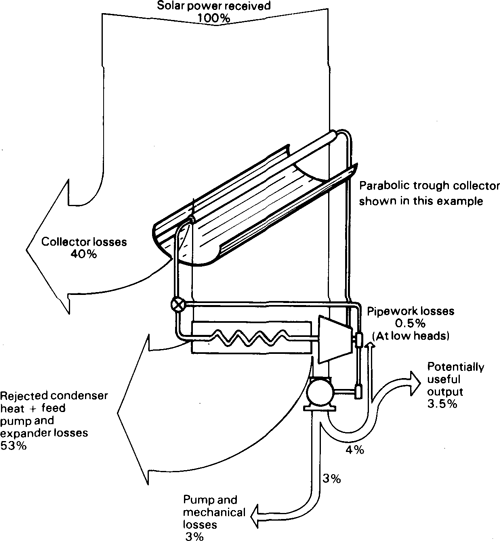
Fig. 132 Losses in a typical solar thermodynamic pumping system
Therefore, although a concentrator improves the thermodynamic efficiency of a solar pumping system, and thereby reduces the area of solar collector needed to achieve a given power output, the added complication increases the cost per square meter of solar collector and also reduces the available solar energy by limiting usage to direct beam radiation. Analysis by Halcrows and I T Power [54] [55], indicates that a compromise of using low concentrating factor line focussing collectors appears to be the most cost-effective approach with current solar collector costs, but that future technical developments could make point-focus systems competitive if a clever, low cost and reliable parabolic dish and sun tracking mechanism is developed. But this would only apply in locations (such as deserts) with a high proportion of direct beam radiation.
Fig. 132 is a schematic diagram of a solar thermal pumping system, showing the energy flow and the principal losses. A good solar collector will typically collect 60% of the solar energy falling on it. Of this 60%, about 7% will be converted to shaft power and the rest is lost as rejected condenser heat, feed pump and expander losses, and finally perhaps 50% of what is left, i.e. 3.5% of the original input, will be converted into useful hydraulic pumped power. This is an example of the better types of small solar thermal systems, many that have been developed are not nearly as good as this in practice.
Systems of this kind depend on a property of certain semi-conductors to generate electricity when exposed to light. The physical principles are explained in broad detail in [57] or in depth in [58]. A number of different photovoltaic cell materials exist, but the only commercially proven power cells currently available are based on thin wafers cut from purified crystals of silicon. The majority of these are sliced from single crystals of silicon and are known as "mono-crystalline" cells. However, a recent process involves the growth of several crystals simultaneously, which when sliced yield so-called "poly-crystalline" cells. Both technologies are competitive at present.
Silicon is an abundant element, but the purification, crystalization and slicing process requires high technology and is expensive. Work is in hand on a variety of cell technologies that promise in some cases improved efficiency and in others lower costs, but none are as yet at the production stage. Some of the so-called "thin film" technologies under development promise substantial reductions in costs which could greatly enhance the scope for using when they become commercially available.
Normal practice with mono- or poly-crystalline silicon cells is to slice them into wafers, which may be circular or square and are typically 100mm across, but quite thin (about 1mm or less). The front and rear surfaces are doped with impurities to create the necessary semi-conductor properties. The rear surface is metalised, while the front has a fine pattern of conducting metal collectors plated on to it which are usually connected by two thicker conductors; see Fig. 133. Light falling on the cell produces a potential difference (or voltage) between the conductors on the top surface and the metalised rear surface. Each cell can develop about 0.4 volts when under load, (0.6V on open circuit), so by connecting a string of cells together in series, a higher voltage can be created.
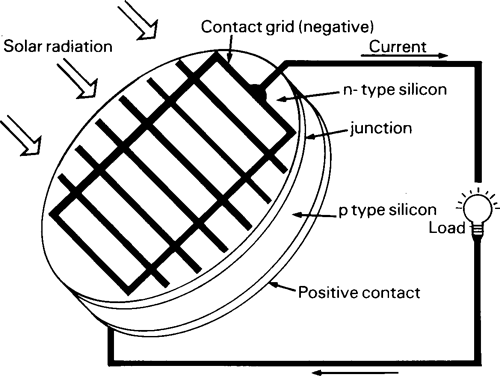
Fig. 133 Construction of a silicon photovoltaic cell
Solar cells are delicate, and expensive, and need to be safely enclosed behind an appropriate window to let the light in. Therefore strings of cells are generally mounted in glass fronted frames known as "modules". Toughened glass is usually used for the cover (this is sometimes given a matt finish to minimise reflection) and the cells are encapsulated behind the glass in plastic with either a metal or glass rear surface. The frame is commonly made of light-alloy and a good seal is needed between the frame and the glass.
Typically, cells are mounted in strings of 36 per module, giving a nominal voltage of 14-16V. 100mm diameter cells typically produce about 1W of electrical output when exposed normal to full strength sunlight amounting to 1000W/m2, so a standard module of 36 x 100mm cells will usually be rated at 35W (recent types with larger and/or more efficient cells are rated at 40W and more).
Solar modules are the most expensive part of a solar photovoltaic system, costing in 1985 typically US $7.00/W(p) (per peak watt); i.e. a standard 40W module currently costs around $280. Fortunately, good quality modules are highly reliable and should last 20 years or more, providing they are not subject to physical damage to the glass covers. A serious worry, once their high intrinsic value becomes more widely known and a "second-hand market" develops, is the possibility of theft.
Modules are mounted on a supporting structure in a frame and this assembly is known as a photovoltaic array which can simply be connected by electric cable to the motor/pump sub-system. Examples of four typical types of solar photovoltaic pumping systems are shown in Fig. 134.
In a few cases arrays have been developed which track to follow the sun; this of course increases the amount of sunlight intercepted as the array will always face the direct beam radiation. However, the complication and expense of providing mechanical tracking has not generally been found worthwhile so it is not common practise. A few portable, or semi-portable small scale solar pumping systems exist in which the arrays can be manually orientated by moving them bodily; here some significant advantage at little effort or cost is gained by facing the array(s) south east in the morning and south west in the afternoon when in the northern hemisphere (or NE and NW respectively in the southern hemisphere).
Most arrays are generally designed to carry the modules at a fixed tilt angle which maximises the amount of sunlight received over the year. It so happens that the theoretical angle for this to be achieved coincides with the angle of latitude of the location. This is because that is the angle which will place the array perpendicular to the sun at solar noon on the equinoxes, and will therefore make the divergence of the sun's rays from perpendicular to the plain of the array a minimum at all other times. In practice, the actual angle for the array is sometimes varied so as to bias the optimization to suit a season having more cloud cover; for example, in areas with a marked rainy season it may be advantageous to incline the array more normal to the sun in that season, and sacrifice a little solar energy in the dry season when perhaps more energy than necessary can be intercepted. Also, although mounting the array at zero angle (i.e. horizontal) is the optimum angle for the equator, it is normally recommended that arrays be mounted at angles of at least 10° so that there will be good rainwater run-off, which helps to keep them clean. It is often advantageous to have an array with a capability of having its angle adjusted manually every few months, as this can improve the output by 10% or more, over the year.
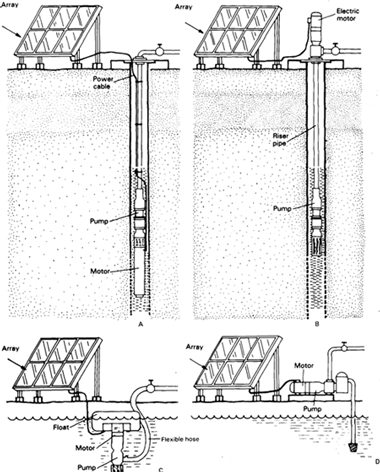
Fig. 134 Examples of solar pump configuration
A. submerged motor/pump set
B. submerged pump with surface motor
C. floating motor/pump set
D. surface motor with surface mounted pump
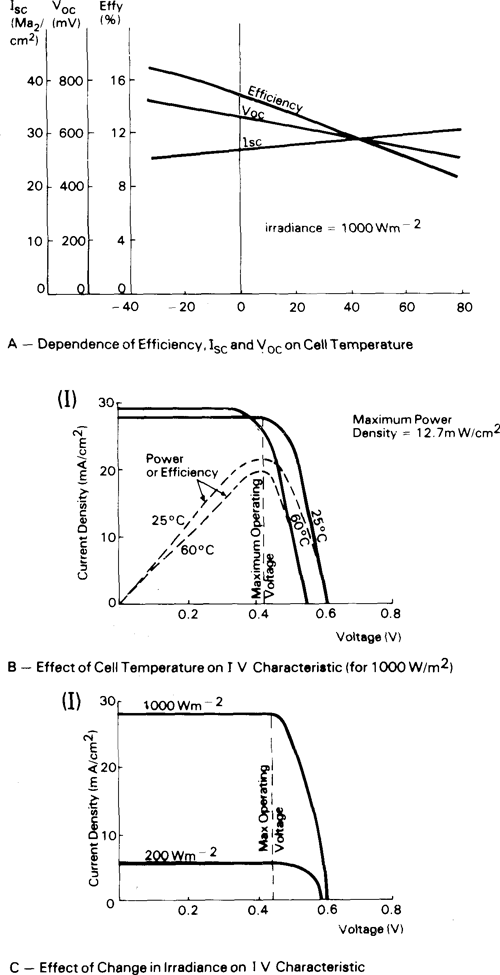
Fig. 135 Performance characterists of silicon photovoltaic cells
The performance characteristics of silicon solar cells are shown in Fig. 135. It can be seen that the efficiency of energy conversion is in the region of 10%; e.g. in peak sunlight (which yields approximately 1000 W/m2) lm2 of silicon cell surface will yield about 100W of electrical output.
Unfortunately, the efficiency of solar cells declines as they get hotter as shown in Fig. 135 A. Most solar cells attain temperatures in the range 50-60°C in full sunlight conditions, but their power rating is generally quoted by manufacturers for an operating temperature of 25°C, which coincides with laboratory conditions for a standard method of testing. They therefore will never achieve their rated output in practise under normal sunshine, but sizing methodologies, such as are described later, take account of this discrepency.
Fig. 135 B indicates the voltage-current (V-I) characteristic of a solar cell, with 1000 W/m2 irradiance. At the one extreme you can short-circuit the cell and get a maximum current Isc (the short-circuit current) of about 30mA/cm2 of cell, but the voltage will be zero. At the other extreme, on open circuit, there is zero current, but an open-circuit voltage, Voc of about 0.55-0.60V per cell, (regardless of its size). The maximum power occurs when the load applied is such that the maximum value of the product of V and I is obtained (electrical power in watts is numerically volts times amps). This occurs near the "knee" of the V-I curve at around 0.4V per cell, as indicated by the dotted curve showing power. As the efficiency is exactly proportional to the power output, the efficiency curve is identical in shape to the power curve.
The sun mostly shines with a strength of significantly less than 1000W/m2, (which is a mid-day intensity), so Fig. 135 C indicates how, if the irradiance is reduced by say 80% to 200W/m2, the current density declines proportionately, but the voltage stays the same. The power from a cell is therefore almost linearly proportional to the intensity of illumination from the sun. Because a voltage is produced even in low levels of irradiance, solar photovoltaic systems can function in low levels of sunlight, depending on the nature of the electrical load and what the threshold power for starting happens to be.
A few manufacturers have produced solar photovoltaic systems with concentrating collectors, using mirrors or lenses to intensify the strength of sunlight on the cells. This allows a smaller area of cells to be used, but the added expense of mirrors or lenses seems to negate any saving on cells, especially bearing in mind the other disadvantages of concentrating collectors discussed earlier.
Photovoltaic pumping systems require, in addition to the array, a so-called "sub-system" which consists of at least an electric motor powering a pump. Fig. 134 illustrates various commonly used configurations that can comprise a photovoltaic pumping sytem. Fig. 136 shoes schematically the necessary (and optional) components of a solar photovoltaic pumping system and how they interact.
Because the output from an array is DC (direct current), either a DC electric motor needs to be used, or alternatively an inverter can be used to synthesize AC so as to allow a conventional mains power AC electric motor to be used. The disadvantage of using an inverter is its cost and the power loss inherent in its use, but the advantage is that many relatively low cost, mass-produced, standard electric pumps can be used.
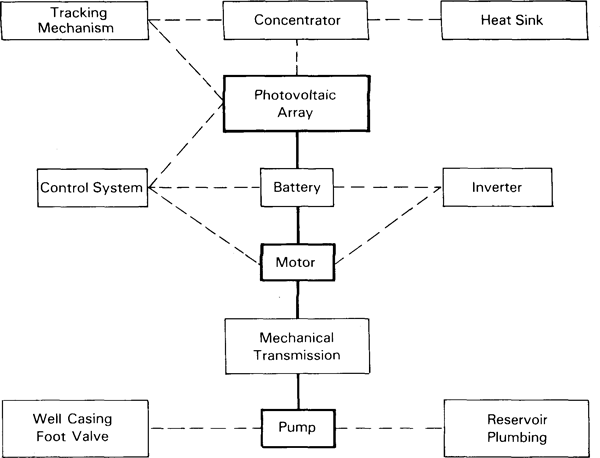
Fig. 136 Schematic arrangement of a photovoltaic solar pumping system. (Note optional linkages shown with broken lines and essential components shown with heavy outline)
Where DC motors are used, the most efficient types are permanent magnet motors, where the flux is provided by magnets rather than an electro-magnetic field coil. A problem with DC motors is that carbon brushes are generally needed and these are a potential source of trouble as they wear and need regular replacement. Brushless, maintenance-free, DC motors have recently been developed however, which have electronic circuitry to perform the same function as a commutator and brushes.
Much of the discussion in Chapter 4.6 in the context of mains (or generating set) electricity applies to the motors and pumps of photovoltaic electric systems. For example, combined submersible motor pump units may be used, (either the borehole type or surface water type) which need either AC or brushless DC motors since they are sealed and therefore not suited to brushed motors. Surface suction pumps direct coupled to motors may be used, or surface mounted motors driving submerged pumps via a long shaft. Also, a transmission may be used to convert the rotary output of a motor to a slower reciprocating output and to drive a standard piston pump.
For irrigation duties, generally at low heads, the most common and useful system is either a submersible motor pump unit, usually suspended from a float for pumping surface water, or a fixed installation usually using a surface mounted motor driving a centrifugal or multi-stage turbine pump via a long shaft. Surface-suction centrifugals also have a role, but self-priming capabilities are essential with a solar power source or the user may need to reprime the pump everytime a cloud passes by.
Because the motor-pump combination will have an optimum performance at a certain voltage and current, the photovoltaic system designer tries to match a motor-pump unit to the array so that it will electrically load the array under all typical irradiance levels so as to keep the voltage and current levels as near to the "knee" of the photovoltaic module characteristic as possible. There is an optimum characteristic curve for any array where the output is maximised under all solar conditions, so the aim is to provide a motor and pump with a characteristic such that with varying currents caused by changes in irradiance level, the voltage requirement follows the array maximum characteristic curve as closely as possible. With good design, centrifugal pumps can be sized to load a system very close to this optimum right across the operating range. Positive displacement pumps, on the other hand, need varying voltage to change their output and therefore they inherently fail to match well with a solar power system. Another difficulty with positive displacement pumps is that they generally need more torque (and hence current) to start than to keep going, which makes starting in low levels of irradiance problematic unless some artificial method to overcome the problem is used.
A general solution to matching arrays and motor-pump units (and to allow for variations in their load lines when operating off the design head, for example), is to use an electronic power conditioning device called a Maximum Power Point Tracker (MPPT). This can convert a DC input at one voltage to a DC output at another voltage. It is possible to sense the output current and voltage and provide a control function which will automatically adjust the output voltage to obtain maximum power for the irradiance level and pump load applying at any time, generally using a microprocessor to make the logical decisions. This approach results in extra cost for the MPPT, plus a small parasitic power loss inherent in any extra component, but in many cases, particularly with positive displacement pump systems, it greatly improves performance. The gains from an MPPT are less worthwhile in the case of well-matched low head direct-driven centrifugal pumps of the kind which tend to be most often used for irrigation duties.
A controversial technical question is whether batteries should be used with solar pumps. While they are not essential, and therefore not often used, they can provide a useful element of energy storage, allowing the system to work when the user wants to use it rather than when it happens to be sunny. Batteries also provide power conditioning capability as an alternative to a MPPT in that they can deliver a different current to that received. However their life under tropical conditions tends to be limited to four or five years, and they need regular topping up with distilled water unless more expensive sealed batteries are used.
As always, each component causes a loss and an inefficiency; the power flow through a typical photovoltaic pumping system is illustrated in Fig. 137. This indicates that, at best, the following efficiencies can be expected:
| photovoltaic modules | 11% |
| motor-pump unit, cables and controls | 45% |
Therefore the actual hydraulic output, ignoring pipe losses will be about 5% of the power of the sun arriving through the window of the array. Pipe losses, even with a well designed low head system, may be another 10% of the hydraulic output, or 0.5% of the total input, giving at best an overall efficiency of 4.5%.
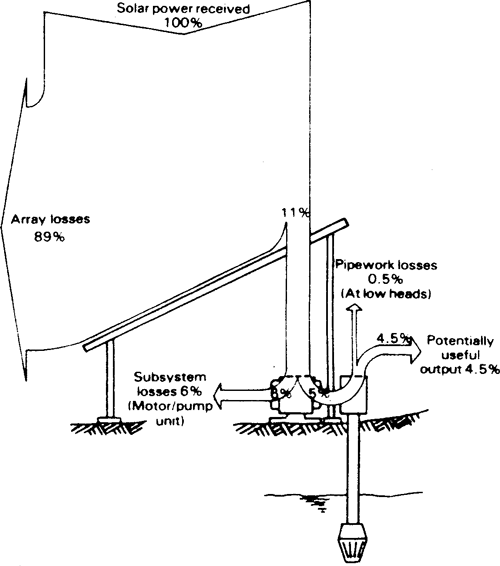
Fig. 137 Losses in a typical solar photovoltaic pumping system
Tests, such as are reported in ref. [59], have shown that the best systems do achieve this level of efficiency, but many systems are not nearly as good being typically only 2-3% efficient or worse. Efficiency is an important factor in selecting a solar pump, because with the high price of photovoltaic arrays low efficiency implies a need for a proportionately larger and more expensive array. A measure of this can be gained by an example of comparing the use of a 70% efficient motor with an 80% efficient one for a 500W(p) system. At this power level, 10% extra array size to make up for the less efficient motor will cost approximately US $300-400. Since the difference in cost between an efficient motor and an inefficient one is usually much less than this, it is obviously worth buying the best motor available. This decision is of course usually made by the system manufacturer and not the user, but the informed user can at least question the choices made by manufacturers by studying their specifications before buying.
The average value of solar irradiance just outside the earth's atmosphere is 1 353 W/m2. Solar radiation is attenuated as it passes through the atmosphere so that the maximum level normally recorded at sea level is around 1 000W/m2. This is made up of two components, the direct beam radiation from the sun and the diffuse radiation consisting of light scattered by the atmosphere from haze, the sky itself and clouds.
The combination of direct beam and diffuse radiation is called the global radiation; the level of global radiation varies through the day because the path length the light has to take through the atmosphere is greatest when the sun appears low in the sky in the early morning and late afternoon and least with the sun overhead at solar noon. For the same reason there are variations with both season and latitude. The total solar radiation received in a day can vary from about 0.5 kWh/m2 on a sunny northern winter day to over 6.0 kWh/m2 on a sunny day in the tropics. Obviously on a cloudy day the solar energy reaching ground can be almost zero. On a really clear, cloudless sunny day diffuse solar energy reaching the ground may be 15 to 20% of the global irradiance, but on an overcast day it can only be 100%.
Because of the variability of solar irradiation, the performance of solar pumping systems can be strongly influenced by location, time of year and weather. However, just like with wind energy, solar energy tends to be consistently available at any particular location from one year to the next; in other words, analysis of past solar energy records allows accurate prediction of solar energy and hence of system sizing. To some extent it is easier to achieve accuracy with solar energy prediction than with wind energy prediction since it is less affected by local site conditions, (providing the site is not actually shaded by trees), and any errors in solar energy measurement have less influence on system performance than comparable percentage errors in wind speed recording.
Accurate sizing of a solar pump array is necessary to minimize the array size for a given duty and thereby to achieve the most cost-effective system possible. If there is doubt about the sizing, a technically acceptable approach is to use a larger than necessary system in order to guarantee an adequate output, but the cost will tend to increase in proportion with power rating; 10% over-size therefore means 10% more expense than necessary.
Solar pumps used for irrigation should be sized for the "critical month"; that is when the system is most heavily loaded in relation to energy available. This is usually the month of maximum irrigation water demand, which fortunately is rarely one of the least sunny months, since crop irrigation water demand and solar energy tend to be well correlated. 'By contrast, a solar pump for drinking water supply duties is likely to need to deliver a constant daily water output, which would in this case make the least sunny month the critical month for sizing purposes.
Fig.138 gives an example of mean monthly solar energy availability plotted on the same page as mean monthly gross irrigation water requirement for the Lake Tchad region of Africa. It can be seen from this that the month of June is not the sunniest month, but it is the critical month in terms of solar irrigation pump sizing, for that is when the water demand is largest in relation to the energy availability. The sunniest month, April, is not a critical month as it is too early in the growth cycle for the crop in question (i.e. cotton), while the fields are fallow in the second sunniest month of March.
Determination of the critical month, the mean daily water demand and the mean daily solar irradiation for that month are the starting points to size a solar pump (and hence to estimate its likely cost). Irradiation figures can be obtained from most national meteorological departments, and they are also published covering the whole world, for each month in references such as [57] [59] (as well as in some of the brochures of several of the larger manufacturers of solar photovoltaic power systems). Such published data are more region-specific than location-specific so there is a good chance of making an adequately accurate judgement simply on the basis of regional irradiation figures.
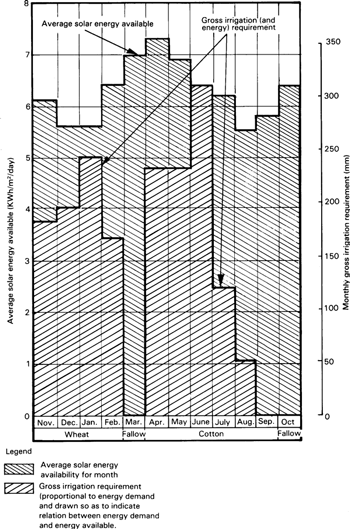
Fig. 138 Solar energy availability compared with crop irrigation water demand (Lake Chad region)
References such as [57] and [60] give a detailed explanation of rigorous methods for solar photovoltaic system sizing, but for most purposes a reasonable estimate can be made using a rule-of-thumb approach, such as the one explained below. In any case, most photovoltaic system manufacturers maintain computer models which they use for sizing systems; these generally include a world-wide data-base, so when requested to provide a quotation they can minimize the system size so as to price competitively. Therefore the potential purchaser should request quotations from several sources and compare the sizings and prices quoted. Care should be taken, however, to avoid simply taking the cheapest system and thereby possibly obtaining one which is undersized for the duty required.
Solar pump economics are discussed in more detail in Chapter 5, but in general terms, solar pumps begin to be economically competitive for applications where:
A rule-of-thumb method may be used to obtain an approximate idea of the size and cost of a photovoltaic array, as follows:

where Q is the output in m3/day and H is the head in metres. eg. 8mm of water on 0.3ha pumped through a head of 10m; the volume is 24m3/day which requires (24 x 10)/367 = 0.654kWh(hyd)/day;
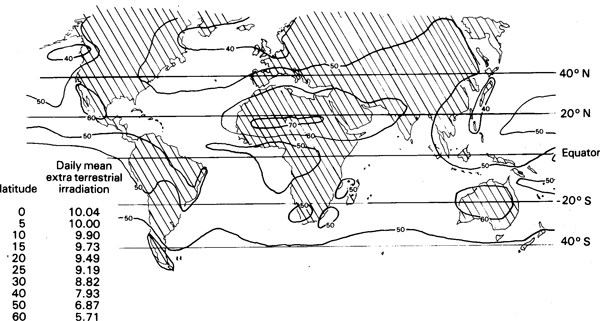
Fig. 139 World map giving average annual Clearness Index for solar distribution
Typical total total solar pumping system costs (1985) can be estimated on the basis of US $15-25 per W(p) of array, depending on the supplier and the specification of the system. Lower powered systems in the region of 200 to 500W(p) will tend towards the upper end of this price range, while higher powered systems, of say 2 000W(p) or more will tend towards the lower end. These figures are of course very approximate, as is the sizing methodology outlined, but with the example worked through we can see that the above example requiring a 400W(p) system, is likely to cost in the region of US $6 000-8 000. These costs are likely to come down during the next few years by perhaps 25 to 50%, as the volume of photovoltaic manufacturing increases.